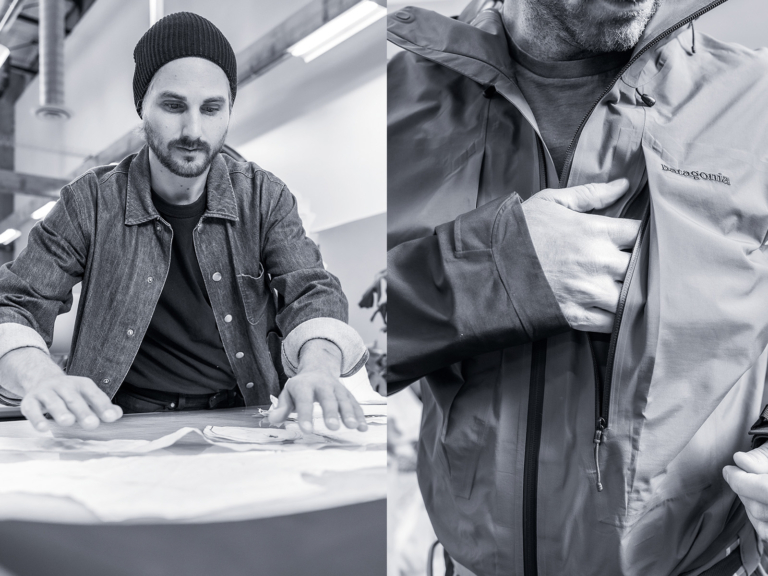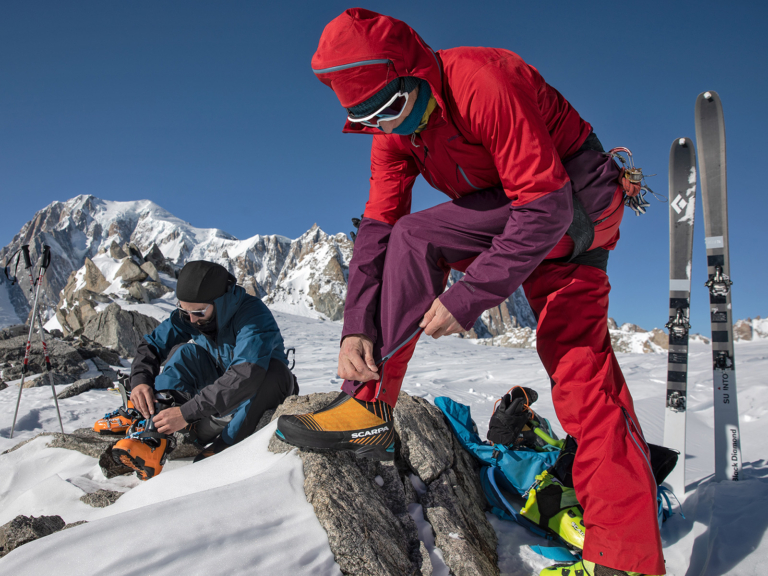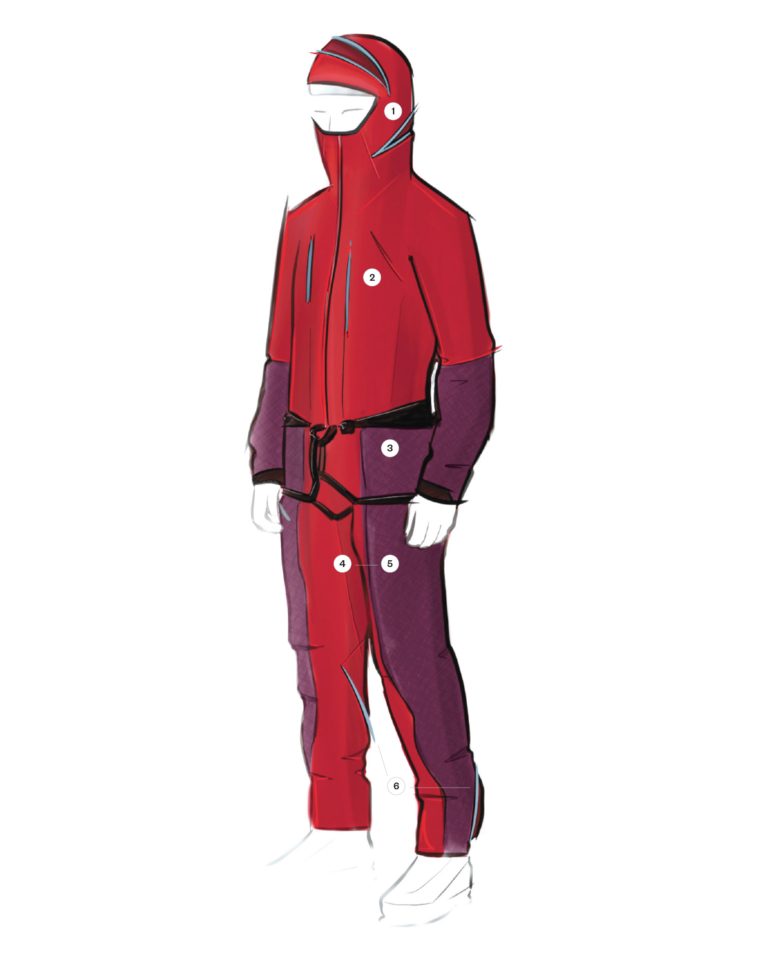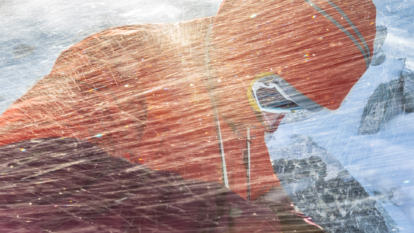Alpine Suit
On an unseasonably warm day in February 2023 in Chamonix, France, Patagonia Climbing Ambassador Matt Helliker and Advanced R&D Designer Eric Noll reunited. After three years of conversations and experimenting, they were finally taking their realized vision climbing. “Out of all my 25 years of climbing in Scotland, the Alps and in the greater ranges, there’s one thing I’ve always wished we made,” Matt says. “A one-piece. When I’m winter climbing, I’m always grabbing my jacket and pulling it back down under the harness,” he adds, which allows cold air and precipitation to sneak under his layers. “All of that could be eliminated if we just had a one-piece hard shell to integrate the layers underneath so that the movement just flowed.”
Conditions were subpar at Col du Géant, too warm for great alpine climbing. But that didn’t stop Eric and Matt from getting out and, more importantly, having time together to try out the suit. “We kicked up a couple unknown couloirs, mixed-climbed a few pitches of rock, skied the Vallée Blanche and summited nothing. It was perfect,” Eric says. And despite not having to face burlier weather, the suit performed beyond both of their expectations. Like an aegis, it provided total full-body protection while feeling like nothing at all.
Matt first shared his idea for a one-piece with Eric in January 2020 while the two were field-testing in Ben Nevis, Scotland. A certified International Federation of Mountain Guides Associations (IFMGA) guide, Matt’s established many first ascents in the Alps and greater ranges. He’s also received an award for high-altitude rescue and has been a trusted field-tester for 25 years. On that Ben Nevis trip, Eric got to experience Scotland’s maritime climate for himself, and he and Matt talked about outdated versions of alpine suits, which were mostly just a top and bottom squashed together with restrictive or redundant features. Matt envisioned instead a “premium piece for the most extreme conditions you’d encounter”—maximum protection and maximum freedom of movement. Although Eric was intrigued, he couldn’t imagine finding the time to develop such a specialized garment. Then came the COVID-19 pandemic, and Eric found the time to tinker.

For a technical piece, there aren’t many features on the Alpine Suit—and that’s the point. Pared down to the absolute essentials, every detail was designed for functionality. “What was really cool working with Matt,” says Advanced R&D Designer Eric Noll, “is that he said, ‘Let’s try and do something new.’ And that was what I got excited about.” Photos: Tim Davis
“Matt and I both knew we could default back to something that was known, but we had the time and space and each other to push the possibilities of what could exist,” Eric says. “We were like, let’s try something new. Like, on everything.”
As Matt and Eric volleyed ideas and videos across WhatsApp, serendipity pushed their passion project from a bespoke experiment to a test case. Gore had finally nailed a new high-performance, waterproof/breathable membrane made without PFCs/PFAS that Patagonia had been testing for years. It was time to show it off. “The material makes so much sense for this piece,” Eric says. “It’s a really cool way to showcase what we’ve done.” That happy coincidence put what would have been a one-off design into a production process that rarely gets to operate with such unique features.

“This moment together was not about the actual climbing, but about the relationship we built over the last few years via the suit,” Eric says. “Those days in the mountains, the shared experience of the suit performing beyond our expectations, gave us a sense of closure on the project.” Field-testing in Vallée Blanche, France, Matt and Eric swap out boots and zip up cuffs on the Alpine Suit as they switch from skiing to climbing. Photo: Andrew Burr
Translating an experimental design created by an idiosyncratic designer to a production-ready garment was always going to pose some additional challenges. In order to tune the material to climbing movement, Eric eschewed 2D sketches and instead draped hand-cut muslin fabric directly on a harness-wearing mannequin. Lillian Crowe, a senior size- and fit-pattern engineer, digitized the pattern. “There’s a lot of articulation built into the shaping of the suit,” she says. “There aren’t darts; it’s all curves … It’s not as easy as a straight line, which allows you to move a seam over an inch without changing the whole pattern.”
Of course, the team had to make sure anyone could wear one. Product Developer Christine Tran adapted wetsuit sizing to adjust each measurement of the suit to fit a variety of bodies at multiple scales. She also helped make sure that the seat zipper was comfortable, functional and passed our Ironclad Guarantee. “We don’t typically do patterns in-house, so it’s always interesting to see how that translates to the factory,” Christine says. “Their machines are different, their programs are different, they have different expertise. Actualizing an idea at a production level is always a fun challenge.”
Though many teams made sure each aspect of the suit is functional, one of its most important benefits is intangible: the confidence it bestows. “When things are looking really grim, if you’re feeling very vulnerable in the mountains and you’re wearing something that makes you feel secure, it’s going to help you survive, right?” Matt says. “I just think it will make you feel pretty indestructible.”

1. Spiral-Zip Hood: A low-profile zipper spirals around the convertible hood. When unzipped, the hood fits over a climbing helmet. Zipped, it fits neatly over a beanie and extra fabric tucks away. Nothing like Eric’s vision had been built before. “I think I spent 25 hours patterning the hood,” Lillian reported.
2. Chest Pockets: Offset bellows chest pockets expand outward to minimize bulk and are large enough so the climber doesn’t have to overthink organization and “every bit of energy can be conserved when in the mountains,” Eric says.
3. No Waistband: To minimize bulk and ensure that every feature enhanced on-route movement, Eric draped the fit mannequin with a muslin prototype and a climbing harness, then moved any seams or folds that could dig or chafe. “Every line is used for shaping, with no excess,” he says. The suit works with mountain suspenders to tailor the fit or hold up the suit during approaches when the top half isn’t needed.
4. Four-Point Gusset: The four-point gusset was built for 360-degree range of motion (the idea came from “ninja pants” Eric was working on with alpinist Colin Haley), so climbers can high- and side-step without any restrictions.
5. Dual-Zip Gusset: “Figuring out how far the opening needed to be to use the toilet was super exciting,” Christine says. The offset gusset zipper allows for quick pit stops, with easy access to layers while wearing a harness.
6. Spiral-Zip Leg Cuffs: More alpinists are using skis to approach remote lines or cross broken-up glaciers. The spiral-zip leg cuffs expand to fit over ski boots and can be cinched down “so you don’t snag yourself with your crampon points,” Matt says.

